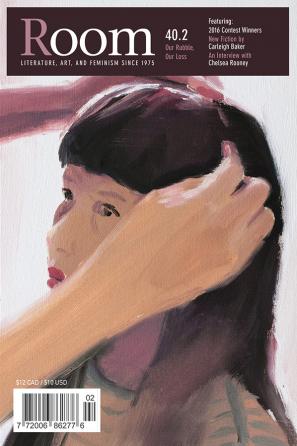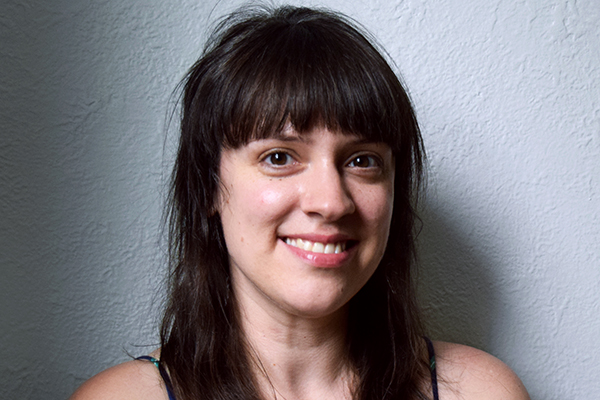Waterloo-based artist Amanda Rhodenizer won our 2016 Cover Art contest with her painting “Attachment.” We spoke to Rhodenizer, whose winning piece appeared on the cover of Room 40.2, Our Rubble, Our Loss, about her process and inspirations.
Waterloo-based artist Amanda Rhodenizer won our 2016 Cover Art contest with her painting “Attachment.” We spoke to Rhodenizer, whose winning piece appeared on the cover of Room 40.2, Our Rubble, Our Loss, about her process and inspirations.
AM: Please tell me more about “Attachment.” In your artist’s statement you mention that you explore themes such as “tensions within relationships, presence and absence between individuals, and symbiosis of parents and children.” How are these themes expressed in “Attachment”?
AR: For “Attachment” I drew upon my own experience of becoming a new mother, while also having strong memories of myself as a child that don’t seem all that distant. Suddenly having a son who demanded all of my time and attention, I found myself feeling like I was losing my identity and autonomy as an artist; I had to start reminding myself that it wasn’t selfish to want to create new work.

“Attachment” was part of a series of paintings that I did of a real-life mother and daughter in which I asked them to face each other in a number of scenarios, including the mother fussing over the girl’s hair. They are much closer in age than myself and my son, and it occurs to me now that I may have painted them as two parts of the same person, each competing for space.
AM: I’m fascinated by the process you describe—beginning with staged photo shoots, then progressing to digitally manipulated images which guide your painting. How did you develop this process? How do these various steps inform your work?
AR: For a while my practice centred around recontextualizing found images and painting them in constructed environments, and the results aligned more with surrealist tendencies. Ultimately though, I found it too limiting to work against the spatial constraints of found images, and so I opened myself up to the idea of shooting my own source material. Working with real models in a rented space still feels a bit like creating a collage in a way, and a lot of times the exciting interactions occur in between the planned shots. From there, I make oil studies to firm up the compositions in paint before I go bigger.
AM: You told Community Edition that you were influenced by the oil painting of Eric Fischl. What is about oil in particular that drew you in?
AR: I’ve always said that oil paint is a very forgiving medium to work with: you can thin it out and make very wet-on-wet paintings; you can build up areas with texture so high it casts shadows; if you know which pigments are opaque or translucent you can achieve really luminous effects; and you can add certain oils to the paint to extend the drying time to allow you to re-work an area even after a day or so.
I’m always awestruck when I see someone who has really mastered using acrylic paint, because it’s something that seems to fight with me each time I try it. Carol Wainio comes to mind as someone who can make acrylic paint look amazing.
AM: In the same interview, you mentioned working with Caroline Walker, who you see as continuing in Fischl’s tradition but “exploring the female dynamic in domestic settings.” You also express wanting to break into the “boys’ club” of oil painting. Can you tell us about how you navigate the gendered “world” of oil painting?
AR: I am so grateful to Caroline, and to loads of other female painters who came before, or are still working today, for disrupting the male gaze and for exploring themes that are actually relevant to women’s lives: work, class, relationships with one another, and the politics of (interior/exterior) space.
My desire to paint probably stems initially from being completely consumed by the long tradition of women being depicted in oil paintings as subject matter. As a young artist, devouring book after book filled with paintings of nude women posing namelessly as allegories definitely had me saying, “hang on a minute . . .” and diving head-first in to making my own images.
AM: Which other artists influence and inspire you these days, in visual art or otherwise? Is literature an influence on your art?
AR: Alex Katz and Fairfield Porter are some steadfast inspirations for me. Chantal Joffe and Lois Dodd. And through social media I’ve been introduced to the work of Kaye Donachie, Daniel Heidkamp, and Njideka Akunyili Crosby—I hope to see all their paintings in person someday.
I do manage to sneak in some time for reading here and there, although not as much as I’d like. I like poetry. I’m drawing some inspiration currently from Laurie D. Graham’s Settler Education, and I just re-read Fishwork, Dear by Alison Smith.
AM: Aside from oil and photography, do you experiment with other artistic media?
AR: I muck around with watercolours from time to time, and I do a minimal amount of drawing, but I haven’t really ventured into other mediums. I did enjoy printmaking while I was in school though . . . And I managed to pick up crochet while I was quitting smoking!
A lot of my ideas for paintings come out of writing down words, actually; just lists of words or small sentences that are enough to use as a jumping off point.
AM: Can you tell us about any upcoming projects?
AR: Right now I’m continuing a project that has to do with land and real estate development in the Waterloo region. During my time as the Doris McCarthy Artist-in-Residence I made paintings that responded to sites of land in Waterloo that were going through some kind of major transition (the area itself has gone through many changes just in the five years that I’ve lived here), so right now I’m now thinking of a way that I could compile them all into a book format. The plan is to eventually launch the book at Open Sesame (a gallery/venue/bookstore in Kitchener) sometime in 2018, and show the paintings along side it.

Untitled (East Forest), oil and acrylic paint on Yupo paper, 9×12 inches, 2017.














